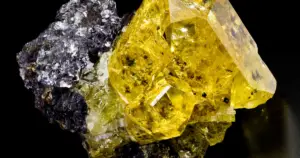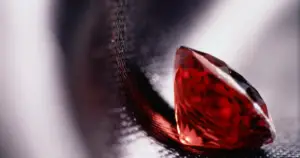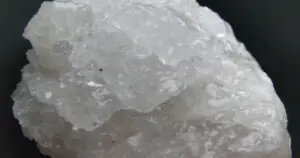Smithsonite Meaning: Healing Properties, Benefits and Uses
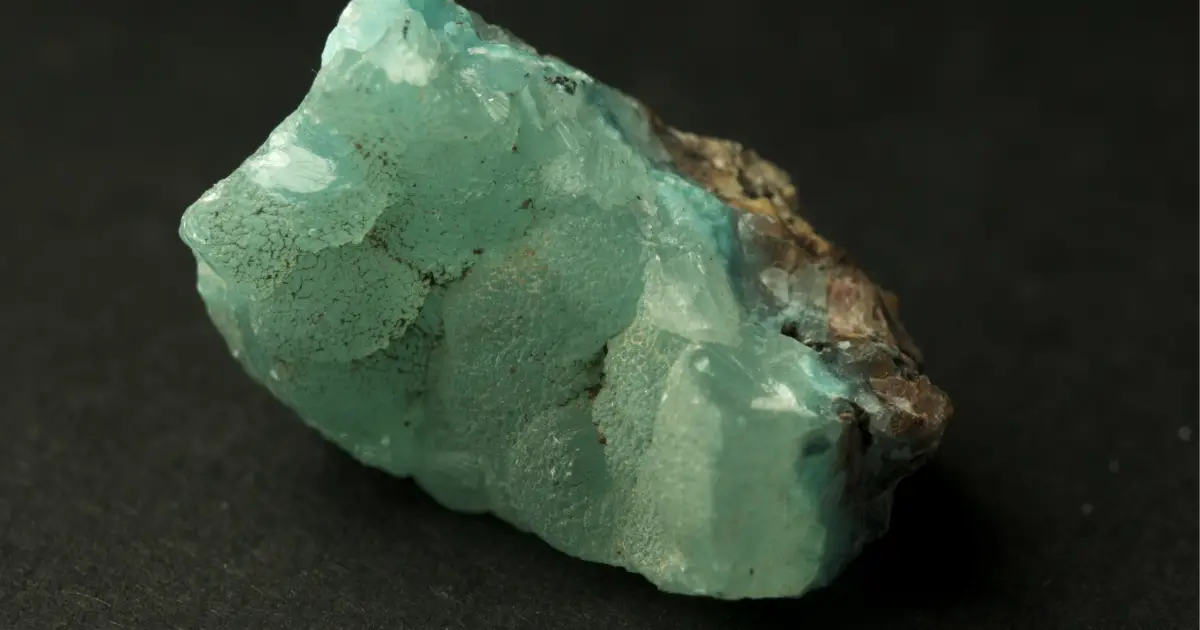
Smithsonite is not an easy stone to find in its crystallized state, making it very rare to come across and valuable to obtain.

Table of Contents
What is Smithsonite?
Smithsonite is a stone that has the most beautiful and delicate shades of the blue gradient. It’s made of zinc carbonate, and that is why it’s known as zinc spar by mineralogists.
How to identify Smithsonite?
For a long time, smithsonite was confused with Hemimorphite. Mineralogists often referred to the stone as calamine due to the same mineral contents and intensity.
- Smithsonite is known for its innocent blue hue, though it comes in different colors.
- There are various shades of blue to smithsonite, quite a vast range. Smithsonite can be available in shades: Blue, Powder Blue, Greenish Blue, and Turquoise Blue.
- Once you’re aware of the color palette available for this type of stone, it will be easier for you to identify them.
- Smithsonite is available in yellow, purple, brown, pink, green, and grey. The color that it is always remembered by is its illuminating turquoise blue.
- It’s not advisable to test the stone using harmful chemicals like Acid, and glycerine that can create an imbalance of chemicals and ruin its longevity.
- Smithsonite is not treated in any specific way, though polishing it at the surface level to retain its shine is an option.
Cuts and shapes of Smithsonite :
- A lot of times people choose not to cut smithsonite due to its rarity, but it is still possible to carve the stone to become a charming piece of jewelry.
- Smithsonite can be seen in honeycomb shapes and diamond shapes.
- Smithsonite is a delicate and rare stone to come across in any other part of the world besides where it originated.
Where is Smithsonite Found?
Smithsonite was popularised once it was named after one of the best mineralogists at that time and drew everyone’s interest. Everyone was intrigued to learn more about this baby blue tined stone and learn more about it.
- Smithsonite is a rare stone. It’s not challenging to locate the stone in different parts of the world in remote locations, which allows the stone to transform into its proper habitat.
- Smithsonite can be discovered in some parts of the world in abundance, and these are a few places that give the perfect environment for the stone to come to life.
- New Mexico
- Namibia and Zambia, in South Africa
- Australia
- USA
- Greece
- Back in 1802, British mineralogist James Smithson identified a particular zinc ore known as calamine, forming two slightly different compounds of the stone which became hemimorphite and smithsonite.
- To help give the stone an identity of its own, Francois Sulpice Beudant chose the stone “smithsonite” in 1832 in a way to honor the renowned mineralogist James Smithson, he’s the founder and a major donor of the Smithsonian Institution.
- As we mentioned earlier, there are colored versions of this stone and some of the most exquisite pieces are from the Kabwe Mine in central Zambia and Tsumeb mine in Northern Namibia.
What’s the Meaning of Smithsonite?
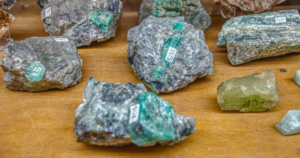
There’s always a set of intriguing questions lingering when it comes to stones and crystals. There’s always a new fact around the corner that enlightens us to look at a particular stone differently, or realize that it fits perfectly with our spiritual goals in life.
Whatever the reason may be, whether you are an avid stone collector or someone on a liberating spiritual journey, you will feel a pull toward a particular stone. A lot of people believe that the energies of the stone call out to us, the stones choose us and not the other way around. Let’s find out if the calming smithsonite is your calling.
- Smithsonite is known to be helpful for those who deal with anxiety and stress. Its subtle tones and calming energies can be comforting in overwhelming situations.
- Smithsonite is an emotive stone in return allowing its user to express themselves better. It can be helpful to use this stone for moments when you feel tongue-tied and can’t bring yourself to have difficult conversations.
With the help of smithsonite, we can power through when things aren’t as clear to us as they once were. Its tranquil energy can help us to remain calm and grounded. Staying collected during testing times is not the easiest thing to do, especially when our emotions are on overdrive, so even a momentary relief is worth it.
Smithsonite Meaning In Ancient History and Folklore
Usually, the story starts with a legend. The stone was probably used for building civilizations or castles, or it was the prime jewel of that time and worn by kings and queens.
Though smithsonite is a delicate and beautiful gem, good enough to be on a crown, there isn’t any recorded history of that. The most popular moment it had was when it was named after the famed mineralogist James Smithson.
Nevertheless, despite its faded history and origin story, smithsonite is now remembered as an elegant stone that dazzles everyone by flaunting its blue gradients and other colors. There is so much to learn about this distinct zinc spar, and its history is being written now.
Crystal Properties of Smithsonite
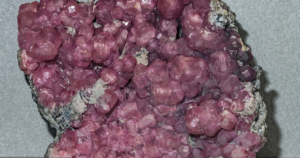
The crystal properties of smithsonite are healing for troubled minds. It has been used to relieve stress and reduce anxiety. Something is comforting about the stone that allows its users to feel a sense of comfort that helps them believe that their troubles won’t last forever.
- Many believe that blue stones are effective mainly on our emotions. It can break free from repressed patterns and regulate them better.
- Smithsonite can decrease stress levels and increase focus during meditative practices.
- Having conversations while feeling pressured can make your tone come across as negative and rude, and create more problems. Smithsonite can help with grounding practices.
Healing Properties of Smithsonite
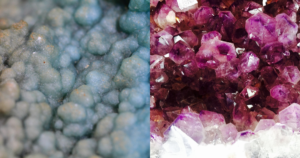
Healing properties that exude from the stones can vary based on their elements. Smithsonite is a soothing stone, and so are its healing properties.
- Smithsonite can help you compartmentalize your emotions and channel them more healthily.
- Smithsonite can clear out emotional blockages and make them flow instead of keeping them stagnant or repressed.
- It can allow you to navigate how to deal with feelings of resentment and anger, doubtfulness, and rage. Someone who might be feeling this way for a long time will try everything to shed these emotions.
Carrying unfavorable feelings around will permit them to weigh you down, and that can affect your quality of life. It can change the way you feel about yourself and carry yourself. Negative emotions can not only affect us emotionally but can affect our overall well-being.
Metaphysical Properties of Smithsonite
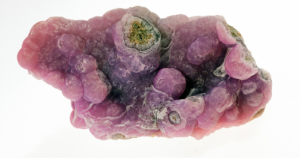
Metaphysical properties are illuminating once you learn more about them. Every stone and crystalline out there contain metaphysical properties that allow the stone to become an integral part of those who are seeking peace, closure, new beginnings, and guidance.
Smithsonite flourishes when it is confronted with a tangled set of emotions. Those who are struggling to find clarity and what their path is in life will find immense comfort in the stone. Instead of hoping that meditation alone will resolve your issues, you can give this stone a chance to become your trustworthy ally in life.
Benefits of smithsonite
We might need more than just one article to explain the benefits of introducing stones into your everyday life. Once you build new routines, you will wish to stay consistent with as much as possible. When it comes to laying down the groundwork for your healing work, you will have the chance to explore the world of stones and what they have to offer.
- Using smithsonite requires patience to gain patience as a valuable trait in life.
- Smithsonite has calming energies, but that does not that it will slow you down.
- The benefits of using smithsonite can show up in your physical and emotional well-being.
For you to experience the benefits of the stone, you have to believe in them too. Everything you believe in will come to fruition.
Smithsonite and Spirituality
Spirituality and stones are interlinked from the start, but it is not necessary to be spiritual to use stones. You can include the stone in your yogic or meditative practices without being spiritual. There’s a majority that solely uses the stone for spiritual reasons only. Two different people with different choices will receive contrasting results.
- Smithsonite’s emotive powers can align your spiritual goals related to emotional growth and well-being.
- The stone can find its way into your spiritual cycle by becoming a meditative stone.
- Smithsonite gives you the strength to remain strong through the difficult seasons of life by safeguarding your resilience.
Spirituality and stones go hand-in-hand and there are ways to reap the benefits of this partnership. It is crucial that you’re using a stone that is compatible with you and aligns with your zodiac’s elements. Using a wrong and incompatible stone can make things imbalanced.
Smithsonite and Feng Shui
Feng shui is an ancient practice that emphasizes order and patterns, inspired by the five different elements that generate active spiritual energies, and how that can affect us and our surroundings. It’s an enlightening process to learn about feng shui and understand the importance its been given for thousands of years.
- Introducing smithsonite in the practice of feng shui can create a harmonious space where families and newly-wed spouses can communicate better.
- Smithsonite in the most active or common area of your house can add its healing energies of reducing stress and anxiety and keep those negative feelings at bay for everyone else in the household.
- Smithsonite’s delicate color will compliment subtle colors around the house and create a tranquil atmosphere at home, or home office.
If you’re someone who doesn’t like to wear stones as jewelry or forget to use them during your meditative practices, then this could be nice to not only include the stone in your everyday life but also reap the advantages without doing much.
Smithsonite and Birthstones
Assigning an accurate stone depending on your star sign is not an easy feat.
Factors that are taken into account are – the time of your birth, the day of your birth, and the month of your birth. These are three main components that astrologers take into account. Those things assess your zodiac sign which can predict a few things about who you are and who can you become.
- Smithsonite is a water element, and it’s compatible to work with water signs that generally have blue stones as their birthstones.
- Smithsonite is fitting for those who identify as Pisces, Aquarius, and Sagittarius as their respective zodiac signs.
- Wearing smithsonite, especially when it’s your birthstone can bring you joy and comfort in different areas of your life, in different relationships.
These days we see pop culture popularising the world of astrology and zodiac signs and include them on their websites and magazines as quizzes or weekly horoscopes. It’s not about associating zodiac signs with something spiritual, zodiac signs are made for you after thorough calculations of time and date and the alignment of your stars when you were born.
Honest astrologers will give you a conclusion only after fully understanding your birth chart. Be aware of scammers!
Smithsonite and Chakras
Chakras, yogic practices, and stones. These three things have come together to create a soul-nourishing process that has changed many lives over the decades. People who are into stone healing, swear by the powers of the stones.
- When you visit an ashram, a meditation room, or maybe even a spa, you will notice stones in specific corners.
- Finding stones and crystals in spaces that are known to bring you a sense of peace and calm will use the practice of feng shui to create the most pristine ambiance.
- The key is to make the other person feel at ease as soon as they enter that space and feel relaxed. Smithsonite is the perfect stone to create that atmosphere.
- Smithsonite aligns with the crown chakra and helps that part of our body the most.
What are the Uses of Smithsonite?
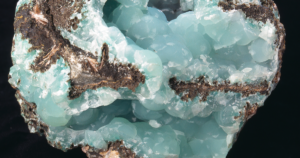
Smithsonite can be used in multiple ways. It’s a stone that’s carved and made as centerpieces or beautiful necklaces. The healing properties of smithsonite can make you feel at ease during uncertain moments in life, help you stay resilient, and keep you calm throughout the process as you find a resolution that wasn’t impulsive.
- Smithsonite can be used as a necklace and be worn around the neck, that way you can always feel at ease.
- It’s a helpful stone for those dealing with anxious thoughts and uneasiness.
- While blue smithsonite is good at dealing with stress, pink smithsonite is good at rebuilding trust. It can help us to start trusting people again and ourselves in moments of self-doubt.
This stone is great for those who have embarked on a journey to heal themselves at the foundational level and truly wish to create healthy patterns and boundaries that align with their emotional growth as a person. It’s not something that happens overnight and requires a lot of patience, but once you learn the importance of being kind and collected, things will become a lot smoother.
Also Read: Alexandrite Crystal Meaning: Healing Properties, Benefits and Uses
How to Care for Smithsonite?
Caring for a delicate and rare stone requires patience and a lot of understanding about the stone. Before purchasing a stone, one should always do research about the content of the stone and learn about its elements. That way they will know to know what is allowed and what isn’t.
When to Cleanse Smithsonite?
Just like everything else in your house that needs to be cleaned in order to last longer, stones are no different. You can clean the stone once a week or wipe it with a dry cloth to maintain its shine. Cleaning stones can be a little tricky for some, and understandably so. There are different elements in most of them and can react differently to the sun, water, and moonlight.
- It’s okay to use water while cleaning your stones and soaking them underwater for a minute or two, only if you can.
- Different stones have different requirements. Smithsonite can be wiped with a lukewarm cloth once a week, and you’re good to go.
- For delicate stones, it’s best to use a soaked cloth that can clean up dirt and hand prints.
- It’s best to clean the stones once a week and twice a week if you’re using them outdoors.
How to Recharge Your Smithsonite
After a long tiring week, everyone wishes to recharge themselves by doing something that brings them more energy. Some work out, practice yoga, go for a walk, or simply catch some sleep. Crystals and stones are no different. You need to recharge them after you use them, but it’s not like plugging your phone into a charger.
These are some of the steps that you can use to recharge smithsonite.
- You can use sprits of water or rose water to awaken its water elements.
- You can use selenite, which is known to help recharge other gemstones as well. It is important to remember to keep them apart and not leave them in close proximity for too long.
- You can use sage in your space and on your stone to get rid of harmful energies that it might have picked either from you or someone else.
It is possible for stones to pass on or project residual energy that can influence the way you feel. Cleansing and recharging is a thorough process and helps with getting rid of toxic energy or feeling that can be bad if you allow them to linger around for too long.
Smithsonite Activation process
After cleaning and recharging your stone, it is time to know how to activate it.
Activating stones is an important step in receiving the stone’s powers and rewards that can help you in your journey.
- Smithsonite can be activated after using rose petals or rose water, or just regular water. There is no particular method that you need to use.
- Moonlight is known to influence water elements the most. Lunar energy from the moon can dictate our emotions and moods.
- You can activate the stone while you meditate as well. The focus that we embody during mediation can be really helpful to activate the stone.
How much is Smithsonite worth?
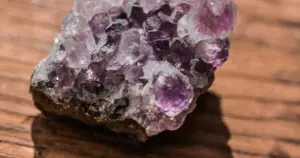
A stone’s worth is driven by factors that can attest to its longevity. Smithsonite is a fragile stone, but not so delicate that it will break at the drop of a hat. You can still cut the stone and turn it into jewelry, but that will leave the stone more susceptible to damage.
- Originality can bring the value up by a lot when it comes to buying original stones.
- The authenticity of the stones and where it is from can determine their worth of the stone.
- Synthetic stones are still worth the hype, but they won’t have the same value as real stones.
Stone collectors that have been collecting stones for decades will know the worth of a stone simply by looking at it. The way its cut, the shape, and form in which it is presented, and the way it shines.
What determines Smithsonite’s Price and Value?
There is great value in something that has stood through the test of time and managed to preserve its quality. It’s not an easy task to take care of delicate stones that require great care and attentiveness in order to last longer in their true element. These things can affect the price and value.
- Smithsonite can be maintained for a long time, mostly as a stone and not as jewelry.
- Some of the purest smithsonites are found in South Africa and Australia and go high up in value depending on their color and shape.
- Botryoidal smithsonite found in Greece and New Mexico can range somewhere between $200 – $400.
- Smaller translucent smithsonite can start at $25 to $35
Smithsonite stones can vary in price range and value depending on where it is being shipped from. Shipping stones and crystals can rack up extra chargers because of being fragile cargo. Smithsonites in Greece and New Mexico have bigger in quantity and are hard to cut, but they are some of the most authentic stones to own.
Smithsonite Impact
Smithsonite is for the reeling heart. It’s a spirited stone for those who are on a journey to find themselves again. There are moments in life that can truly test us emotionally and mentally, and shake us in a way where it becomes difficult to focus on ourselves. In moments like this, smithsonite can be the ultimate guiding stone that can bring us out of that dark place.
Does Smithsonite make a good jewelry stone?
Smithsonite is an elegant stone to wear as jewelry, but it is not the easiest to maintain as it is prone to damage. It is often seen in collections or on displays by those who are fond of collecting stones, rather than safeguarded as a necklace or a ring.
- Though it is difficult to maintain the stone as a jewelry piece, it is still possible to maintain it by mounting correctly.
- You can make smithsonite retain longevity by putting them in fitted mountings that offer optimal protection and support.
- If it’s being used as jewelry, then it’s best to wear it as a pair of earrings or put it in a pendant. Avoid rings as an option as that can be very risky and cause inclusions and damages easily.
Smithsonite Real vs Fake
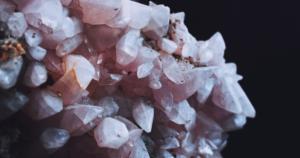
There’s always a dupe available for any type of stone. It doesn’t matter if it’s diamonds or opals, or smithsonite. Replica and dupes for stones and crystals are long-running trades by those who benefit from people’s naivety. Its so important to be careful when you’re buying stones online either through direct sellers or online websites.
- It’s so important to verify if the seller is verified to sell expensive, exquisite stones. It’s not common for just anyone to own highly valued crystals and minerals.
- Going through your options online, do not decide based on images alone.
- Smithsonite or any other stone can be replicated very strategically by dishonest sellers at the cost of an authentic stone, be wary and ask questions!
| Name of Crystal | Smithsonite |
| Precious | Yes |
| Semi-Precious | No |
| Other Names | Zinc Spar |
| Origin(s) | Namibia and Zambia |
| Color(s) | Greenish blue – Turquoise blue |
| Formation | Zinc Carbonite, Iron, and Magnesium |
| Majorly Found at | Namibia, Zambia, Greece, and Australia |
| Zodiac Suited for | Virgo and Pisces |
| Chakra | Crown Chakra |
| Crystal Meaning | It’s a trigonal mineral that is great for calming a troubled mind. Smithsonite encourages keeping a steady headspace in the midst of turbulent situations. |
| Types of Crystal | Zinc Spar, Zinc Carbonate |
| Healing Properties | Heightened awareness, brings clarity, and helps with nervousness and stress. It’s a stone that can help relieve anxiety, depression, and hypertension. It’s helpful to carry the stone in the form of a ring or a cuff stone and wear it during therapy sessions or appointments. |
| Health Benefits | Increased Clarity, Reduces Brain Fog, Reduces heart palpitations induced by anxiety |
| Uses | Calming, meditative stone, or used as a necklace or ring alternative |
| Goes in Water? | yes |
| Goes in Salt Water? | yes |
| Goes in Rain Water? | yes |
| Goes in Moon Water | yes |
| Moh’s Scale | 3-1 |
| Real | A real smithsonite stone can be recognized under certain lighting and look authentic. It has a distinct look that doesn’t make its translucent colors look see-through. The opacity of the stone will still look like a strong color |
| Fake | Fake Smithsonite will look like a glass stone that is painted over and overly polished to make it look like real. |
FAQs
What is smithsonite used for?
Smithsonite is used for its healing properties to treat stress.
Is smithsonite a gemstone?
Yes, smithsonite is a gemstone.
How is smithsonite formed?
Smithsonite is mostly made of zinc content, giving it the name Zinc spar.
What is smithsonite made out of?
Smithsonite is made of zinc carbonate.
What chakra is smithsonite?
Smithsonite affects the crown/root chakra.
Is the smithsonite rare?
It is a rare stone.
Where is smithsonite stone found?
Smithsonite is found in South Africa, Australia, USA, and New Mexico.

